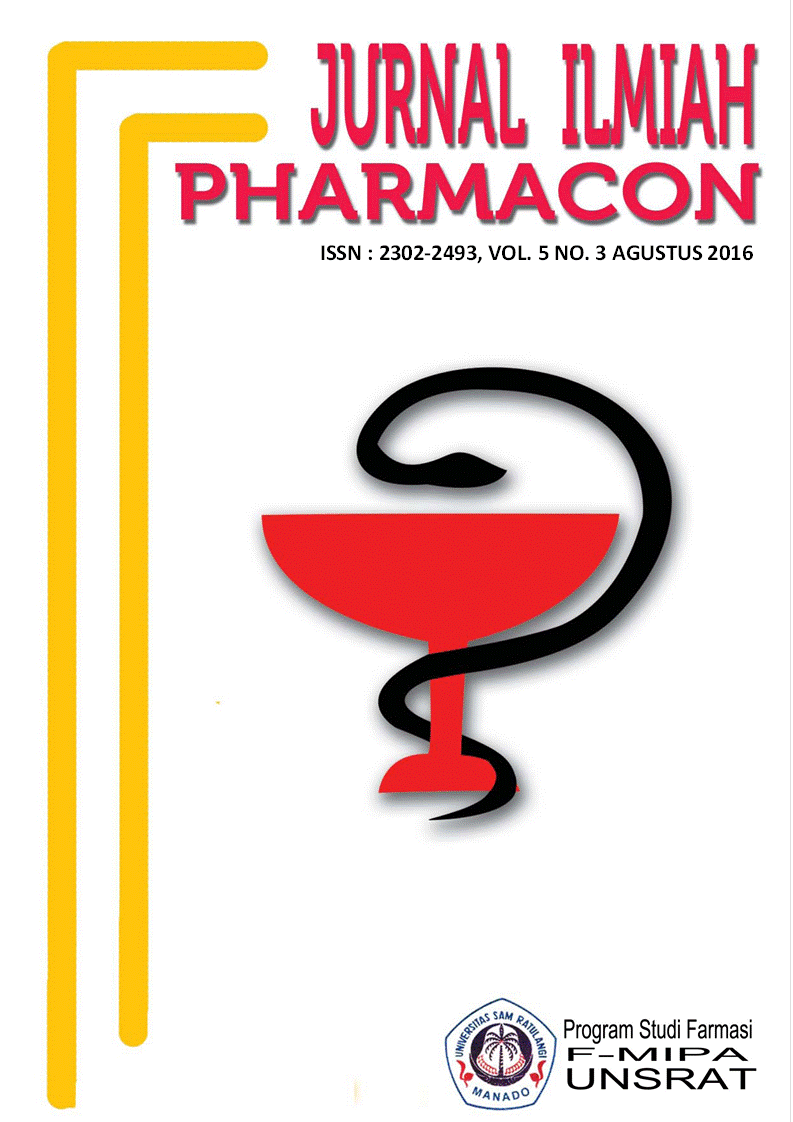IDENTIFIKASI SENYAWA FITOKIMIA DAN UJI TOKSISITAS EKSTRAK ETANOL DAUN LOLA KAHORI (Erythrina variegata L.) DARI TIDORE KEPULAUAN MENGGUNAKAN METODE BSLT
DOI:
https://doi.org/10.35799/pha.5.2016.12943Abstract
IDENTIFIKASI SENYAWA FITOKIMIA DAN UJI TOKSISITAS EKSTRAKÂ ETANOL DAUNÂ LOLA KAHORI (Erythrina variegata L.) DARI TIDORE KEPULAUAN MENGGUNAKAN METODE BSLT
Stela G. Warara1), Edwin De Queljoe2), Herny Simbala2)
1)Program Studi Farmasi FMIPA UNSRAT Manado, 95115
2)Jurusan Biologi FMIPA UNSRAT Manado, 95115
ABSTRACT
Lola Kahori (Erythrina variegata L.) is a medical plant used empirically as anti-inflamatory, anti-cancer and anti-malarial. Lola Kahori Leafs is the most frequently parts used as traditional medicine. This research aims to identified phytochemical compound and to determine the LC50 toxicity value of ethanol extract from Lola Kahori leafs through the toxicity assay using BSLT method. Extraction was done by ultrasonication method using ethanol 95% solvent. Phytochemical screening was done according to Harborne method include identification of alkaloids, triterpenoids, steroids, flavonoids and tannins. Toxicity assay had been used BSLT method to count the lethality amount of shrimp larvae that put in solution test provided in four concentration of 1 mg/L, 10 mg/L, 100 mg/L, 1000 mg/L and control solution. The observation has done every 60 minutes in 24 hours. The value of LC50 obtained based from the calculation of shrimp larvae lethality percentage used probit analysis. The result of phytochemical screening showed that ethanol extract from Lola Kahori leafs has phytochemical compounds containing alkaloid and tannin. Ethanol extract from Lola kahori leafs has tended the most toxic to brine shrimp according the value of LC50 that is 55,719 mg/L.
Keywords : Lola Kahori (Erythrina variegata L.), Phytochemical Screening, Toxicity
Assay, Brine Shrimp
ABSTRAK
Tumbuhan Lola Kahori (Erythrina variegata L.) merupakan tanaman berkhasiat obat yang telah digunakan secara empiris sebagai antiinflamasi, antikanker dan antimalaria. Bagian tumbuhan ini yang biasa digunakan sebagai bahan pengobatan tradisional adalah bagian daun. Penelitian ini bertujuan untuk mengidentifikasi senyawa fitokimia dan menentukan nilai toksik LC50 ekstrak etanol daun Lola Kahori melalui uji toksisitas menggunakan metode BSLT. Ekstraksi dilakukan dengan metode Ultrasonikasi menggunakan pelarut etanol 95%. Pengujian fitokimia dilakukan dengan metode Harborne meliputi identifikasi alkaloid, triterpenoid, steroid, flavonoid dan tanin. Uji toksisitas dilakukan dengan menggunakan metode BSLT untuk menghitung jumlah kematian larva udang yang dimasukkan dalam empat larutan uji dengan konsentrasi larutan yaitu 1 mg/L, 10 mg/L, 100 mg/L ,1000 mg/L dan larutan kontrol. Pengamatan dilakukan setiap 60 menit selama 24 jam. Nilai LC50 didapatkan berdasarkan perhitungan persen kematian larva udang menggunakan analisis probit. Hasil identifikasi fitokimia menunjukkan bahwa ekstrak etanol daun Lola kahori mengandung alkaloid dan tanin. Ekstrak etanol daun Lola kahori bersifat sangat toksik terhadap larva udang berdasarkan nilai LC50 yang diperoleh yaitu 55,719 mg/L.
Â
Kata kunci : Lola Kahori (Erythrina variegata L.), Identifikasi Fitokimia, Uji
Toksisitas, Larva Udang.
Â
Â
Downloads
Published
How to Cite
Issue
Section
License
Authors who publish with this journal agree to the following terms:
- Authors retain copyright and grant the journal right of first publication with the work simultaneously licensed under a Creative Commons Attribution-NonCommercial 4.0 International License that allows others to share the work with an acknowledgement of the work's authorship and initial publication in this journal.
- Authors are permitted and encouraged to post their work online (e.g., in institutional repositories or on their website) prior to and during the submission process, as it can lead to productive exchanges, as well as earlier and greater citation of published work (See The Effect of Open Access)










